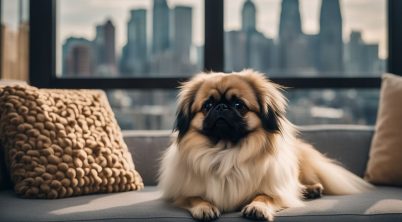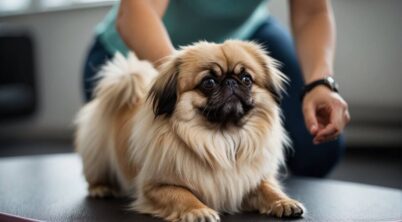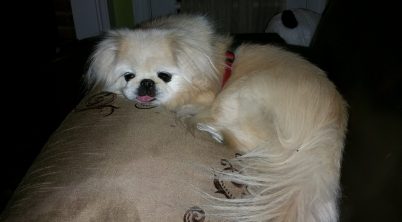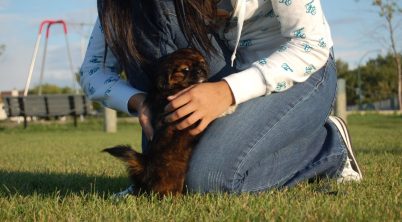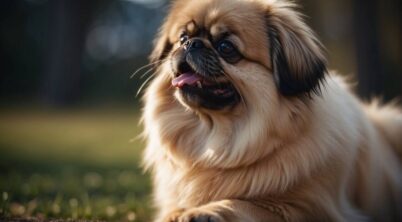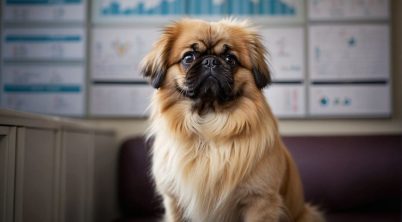The Pekingese is a small dog breed with a rich history tied to the imperial courts of China. Originating from the land of ancient dynasties, these dogs were once cherished by the Chinese royalty, finding special favor during the Tang Dynasty. Bred to be companions to the royal family, they epitomized the luxury and opulence of the imperial lifestyle. Legend has it that the breed was created from the lion, a sacred animal in Buddhist tradition, which gives the Pekingese its alternative moniker, the “lion dog.” The breed was little known outside of the palace walls until the 19th century when British troops entered the Forbidden City during the Second Opium War and brought these prized canines back to Britain as a gift to Queen Victoria, marking the beginning of their Western journey.
Renowned for their distinct body shape, Pekingese dogs boast a compact, pear-shaped frame. They possess a heavy front with a broad forechest, lending them a somewhat bowed appearance, and a narrower waist that leads to a lighter rear. Despite their small stature, they are often described as surprisingly heavy for their size, a testament to their stocky, muscular build. The breed is characterized by a particular rolling gait, a consequence of their body structure, which includes a wide and flat skull, short snout, and large eyes that contribute to their unique, expressive faces.
These small but dignified dogs still carry themselves with the air of nobility that once graced the halls of the Chinese imperial family. Their long, flowing mane, resembling that of a lion, serves as a regal cloak that complements their proud and slightly aloof demeanor. While Pekingese may no longer roam palatial gardens, they continue to command respect and adoration as cherished companions in homes around the world.
Table of Contents
Pekingese Body Shape
The Pekingese dog exhibits a unique and distinctive body shape that reflects its ancient heritage. This breed typically features a compact, stocky form that is close to being as long as it is tall, although some dogs can be a bit longer than they are tall.
Physical Attributes:
- Compactness: They possess a square-build due to a broad, flat skull and short back, giving them a sturdy appearance.
- Front to Back: The front of the Pekingese’s body often appears more substantial when compared to the rear, establishing a pear-shaped profile.
- Leg Structure: Their limbs are slightly bowed, which contributes to their unique stance and waddling gait.
Measurements:
- Height and Length: A balanced ratio between the length of the body and height at the withers is characteristic of the Pekingese.
- Weight: There is considerable variation in the breed’s weight, but balance and compactness are key.
Coat and Shape Visibility:
- A long, dense coat typically adorns the Pekingese. This breed is well-known for its “lion’s mane” around the neck and shoulders, which should not obscure the overall shape of the dog. Fine grooming can accentuate the Pekingese’s body outlines despite its abundant coat.
- Tail Set and Shape: The tail is usually set high and arches over the back, aiding the breed’s typical outline without curling or having kinks.
The Pekingese’s body shape is not merely ornamental but also a testament to the breed’s history as a companion of Chinese royalty, created to present a dignified and proud stature.
Physical Characteristics
The Pekingese breed is distinctive in its physical form, exhibiting traits befitting its historical status as a canine companion to Chinese royalty. Their build is compact and muscular, topped with an impressive coat, and they carry with them an appearance that is both regal and lion-like.
Size and Proportions
- Height: Typically 6-9 inches at the shoulder.
- Weight: Up to 14 pounds, with strict weight standards for conformation shows.
The Pekingese presents a compact and stocky body, heavy for its small size. Despite their small stature, they have a muscular and broad-chested build, which gives them a robust appearance. Their size contributes to their rolling gait, which is a notable aspect of their movement.
Coat and Colors
- Texture: Outer coat is coarse; undercoat is soft and dense.
- Mane: Pronounced around the neck and shoulders, reminiscent of a lion’s mane.
Pekingese possess a long, dense coat that comes in a variety of colors, including but not limited to:
- Tan
- Red
- Black
- White
- Cream
- Sable
- Gray
- Black and tan
- Fawn
- Biscuit
The variety in coat color offers a vast spectrum, adding to the breed’s visual appeal. The coat requires regular grooming to maintain its splendor and to prevent obscuring the dog’s shape.
Distinctive Features
- Facial Structure: Brachycephalic, with a short snout.
- Expression: Large eyes with a “V-shaped” facial wrinkle, adding to their unique expression.
Their “lion-like” demeanor is highlighted by distinctive facial features. The Pekingese’s brachycephalic nature is evident in their short snout. Combined with their large, expressive eyes and the characteristic facial wrinkle, these features create the Pekingese’s unmistakable and dignified expression.
Breed History and Recognition
The Pekingese breed, often referred to as “Peke” or the “lion dog,” has a storied origin deeply embedded in Chinese history. They are believed to have been companions to the Chinese royalty, specifically during the Tang Dynasty, serving as a symbol of regal dignity.
A notable incident in the breed’s history occurred in 1860 when British troops invaded the Chinese Imperial Palace. During this incursion, several Pekes were found and brought to England, one becoming a companion to Queen Victoria, which significantly increased the breed’s recognition in the West.
Throughout centuries, these dogs have been revered, with a legend stating that the Pekingese is a product of a lion blessed by Buddha to become a smaller dog, retaining its brave heart and noble character. This legend reflects in their confident and sometimes imperious demeanor.
The American Kennel Club (AKC) officially recognized the Pekingese in 1906, and the Pekingese Club of America was established shortly thereafter in 1909. Both organizations work to ensure the breed’s standards and integrity are upheld.
When considering a Pekingese, prospective owners are encouraged to seek out a reputable breeder or consider adoption from shelters to find a healthy and well-socialized Peke. Their distinct body shape is characterized by a compact, stocky build, notably lower to the ground in the front than in the back, creating a pear-like silhouette. The Pekingese’s life expectancy generally ranges between 12-14 years.
Their lineage can be traced alongside other Chinese breeds, like the Shih Tzu and Pug, further establishing the Pekingese’s deep-rooted connection to the imperial family. Despite its small stature, the breed has maintained a considerable presence as a favored companion through the annals of history.

